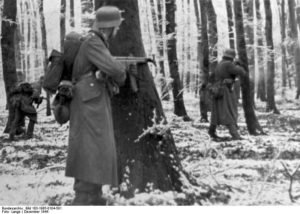The Battle of the Bulge (December 1944) by Mark Lindberg
Towards the end of 1944, Supreme Allied Commander Dwight Eisenhower felt that Hitler’s Third Reich was near collapse. For six months, a half dozen Allied Armies had driven from the beaches of Normandy to the German border. Since 1942, the Soviets had been slowly grinding down the three German Army Groups that were positioned on the Eastern Front. As December of 1944 approached, the American 1st Army under General Hodges was situated between British General Montgomery’s 21st Army Group to the North and General Patton’s American 3rd Army to the South.
However, for months the Germans had been secretly assembling equipment and transferred two dozen battle hardened divisions from the Eastern Front. On December 16, 1944, over 200,000 well equipped Germans attacked 80,000 American troops through the Ardennes Forest. Among the American troops defending this 90 mile front were many inexperienced replacements.
Since the failed assassination attempt on July 20, 1944, Hitler was very suspicious of the regular German Army and began to prefer even incompetent but loyal SS leadership and units. Such was the case when Sepp Detrick and the 6th SS Panzer Army spearheaded the Ardennes attack. The German plan depended upon surprise, continuing poor weather to keep allied air power grounded, and speed to reach essential American fuel supplies. Due to strategic bombing, the German economy was desperately short of almost everything and especially petroleum.
During the first few days, the Germans forced a massive Allied retreat creating a 75 mile bulge in the battle lines as the Americans retreated into Belgium. There were only a few main routes through the Ardennes and stiff resistance from retreating American units from battalion size would often delay a entire German Division for several critical hours.
Now it was General Eisenhower’s time to muster reserves and make a stand. The 101st Airborne Division was relocated to join one brigade from each of the US Army’s 9th and 10th Armored Divisions at the crossroads town of Bastogne, Belgium. Anxious to keep moving and out numbering the Americans about 3 to 1, the Germans attacked day and night during very cold weather. When offered surrender terms, the acting commander of the 101st, General McAuliffe, replied “NUTS.”
By the time the Germans deciphered this American expression, General George Patton had already turned most of his 3rd Army ninety degrees and was moving north to relieve Bastogne. By Christmas, Bastogne was relieved and the weather cleared to allow the Allied air power to destroy irreplaceable German equipment stranded without fuel. After major losses by both sides, the Germans retreated. By February, 1945, the “Bulge” was negated and in May the Third Reich made an unconditional surrender following Hitler’s suicide. Most of Europe lay in ruins with tens of millions dead and wounded. – Mark Lindberg, Mountain, View, CA
Revised December 2017 following a WWII tour in June 2017 that included 3 days at locations from The Battle of the Bulge



